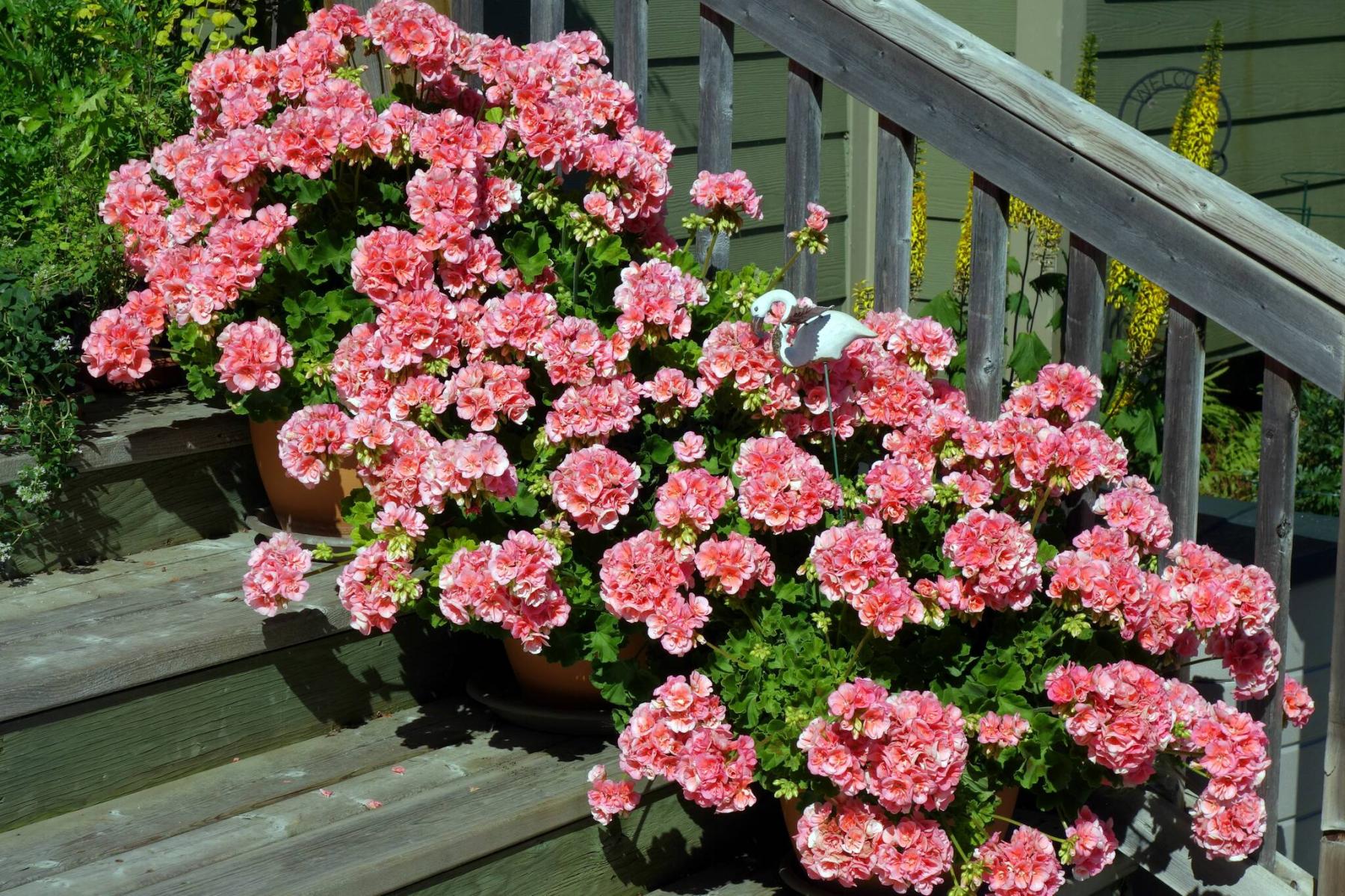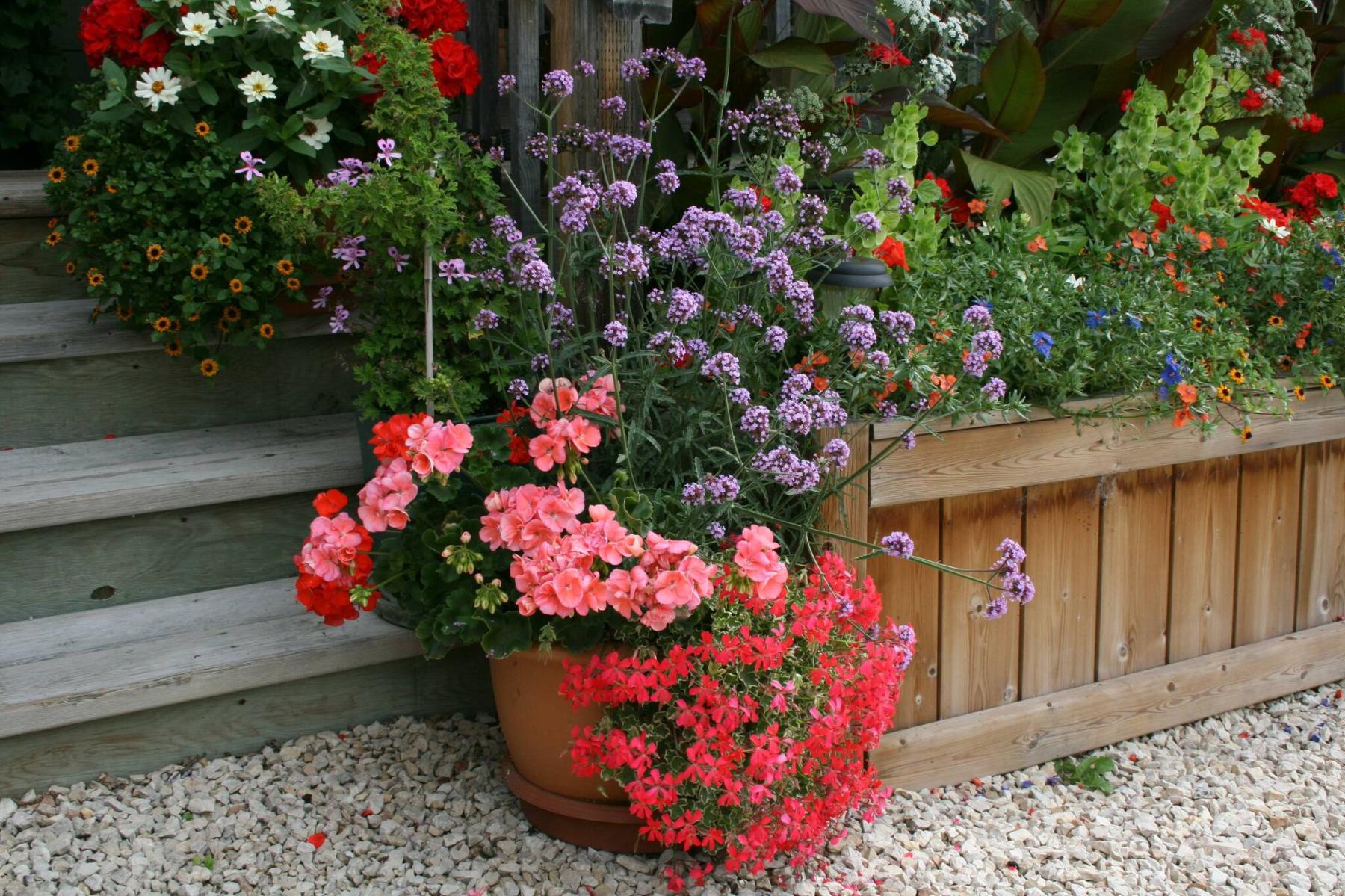
Cheryl Geske
Why propagate geraniums from cuttings? Often the result is bigger flowers and more blooms.
The geranium’s staying power differentiates it from the competition. Flower trends come and go but geraniums are timeless and have been a mainstay in gardens and patio containers since the seventeenth-century. What we commonly call geraniums – the annual flowers we grow in North America — are more accurately referred to as pelargoniums in Europe. The true geraniums are the hardy perennials known as cranesbill geraniums. Far more gardeners, however, grow the annual types – zonal, ivy, regal or Martha Washington, scented leaf, fancy leaf, and interspecific – but the name that sticks is simply geranium.
Interspecific geraniums combine the best traits of zonal and ivy geraniums and represent the latest advances in plant breeding. With greater heat and drought tolerance, interspecific geraniums are very resilient. New for 2024, the Santana interspecific geranium series from Dummen Orange has been selected to have a habit that is not as upright as a zonal geranium, making it an excellent choice for hanging baskets. Santana comes in seven colours. This year in my garden I trialed Santana Purple, White, Pink, and Dark Red which are solid colours but there is also Fire along with stunning splash types called White Splash and Pink Splash. Each variety boasts uniformity in vigor, habit, branching characteristics and flower timing. Santana grows to a height of 12 to 18 inches or 30 to 46 cm.
Super Moon Compact Violet is a new floriferous zonal geranium for 2024 from Selecta with ultra-dark green leaves, vibrant blooms and strong stems. Both the Santana and Super Moon Violet geraniums were still blooming in my garden at Thanksgiving. It’s not easy pulling up geraniums that still look beautiful in early October and tossing them in a compost bin. But for someone like Cheryl Geske, that’s not even a consideration. Geske grows 17 different types of geraniums in her Gimli garden including fancy leaf varieties such as Skies of Italy and starts hundreds of cuttings each fall.
This has been an exceptional year for geraniums, says Geske. “The growing season started so early and extended well into September but also it was so hot that it worked for my geraniums and peppers which are both known to tolerate heat, but the heat didn’t work so well for some other types of plants,” says Geske. “My geraniums were so incredible that you couldn’t see the leaves. They were absolutely breathtaking.” Geske propagates geraniums from stem cuttings. Last fall when she brought her potted geraniums into her garage, she grew 223 new plants from cuttings. Some years she grows more than 400 cuttings. She grows the cuttings into larger plants over the winter and in spring she uses them to decorate her lakeside property. “I put two in a pot, sometimes three, and I also plant many geraniums in the ground.”
Geske usually grows a wealth of colourful annuals in her spacious garden but has decided to grow mainly geraniums next year. “Geraniums are so beautiful, but they are also drought tolerant, and everyone loves them – people and pollinators.” Geske is also thinking about the money she will save. At some local garden centres in May, for example, geraniums in 4.5-inch pots sold for $5.76 to $5.99. Not all gardeners want to start their own plants from cuttings in fall and grow them indoors over the winter but for someone like Geske who wants a large quantity of plants and is also keen to preserve her favourite varieties, propagating from cuttings is a viable option. You may want to try it, too. Here are the basic steps that Geske follows.
Geske moves her geraniums into her garage prior to any risk of frost. She selects plants with healthy, squat, and fat shoots and removes any flower buds. The day before she takes cuttings, she waters the plants with a liquid fertilizer which she dilutes to about half the strength. “Make sure that all your tools are sterilized as geraniums can be very susceptible to fungal diseases during propagation,” says Geske. It is important as well to sterilize the pots you are using for cuttings by washing them in a very mild bleach solution (one part household bleach to nine parts water). Rinse thoroughly with fresh water.
Take cuttings about two or three leaf joints from the top of a stem. Cut the stem just below a leaf node (the small swelling where new leaves develop) and remove the bottom leaves on the cuttings leaving only the uppermost leaves. “This produces a bare stem that can be inserted easily into the starter medium,” says Geske. “Be sure to leave at least two to three leaves on your cutting which needs chlorophyll to carry on the process of photosynthesis.”
Next, dip the base of each cutting in a small amount of rooting hormone to stimulate root growth. Geske uses #2 rooting hormone. Lightly tap the stem to remove any excess. Using a dibber, make a hole in the soil and insert your cutting. Geske uses six-cell trays which she fills with Pro-Mix Biostimulant Growing Medium. Water the cuttings enough to moisten the soil but do not saturate the soil. Do not allow the soil to dry out.
If you are starting a few cuttings, place the small pots on a bright windowsill away from any direct sunlight. Geske starts her cuttings in her basement on heat mats under grow lights. “The most important consideration is to ensure an even temperature throughout the day – not too warm during the day or cold at night,” she says. Good ventilation will help to reduce the risk of a fungal infection. It is a good idea to label your plants. If you are unsure of the variety name, label them by colour.
“Geranium cuttings should root in about 10 to 20 days,” says Geske. Once rooted, she transplants them into 3.5 inch pots filled with sterile potting mix and a small amount of compost. When you transplant, keep as much of the original growing mix around the roots of your cutting to ensure you do not disturb the new growth, she says. “Make a hole in the soil deep enough for the new root ball, about an inch deep. Place the cutting into the hole and fill with soil, tamping lightly around the base of the plant and water your plant in.” Geske waters her new seedlings when the top two inches (5.08 cm) of soil becomes dry. Two weeks after transplanting, she applies a liquid fertilizer at half strength. To encourage bushy growth and side shoots, pinch or cut back your seedling at the tip. Geske removes flowers as they appear.
Geske grows her hundreds of transplants under grow lights in her heated garage where she maintains the temperature at 18 degrees Celsius. It’s the perfect escape all winter long, says Geske.
Will you grow geraniums from cuttings or buy new varieties next spring? Why not plan to do both.
colleenizacharias@gmail.com
For advice, ideas and tips to keep your outdoor and indoor plants growing, sign up to receive Winnipeg Gardener, a free monthly digital newsletter I write for the Winnipeg Free Press at https://www.winnipegfreepress.com/newsletter/winnipeg-gardener .




